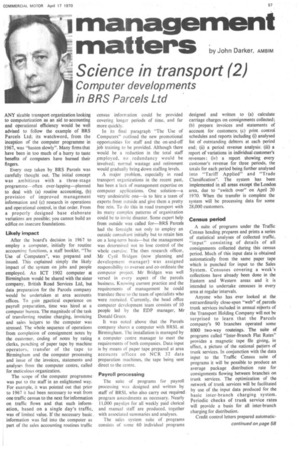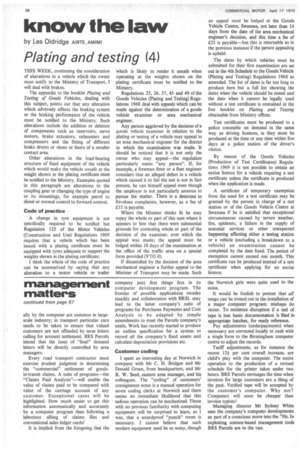management
Page 59

Page 60

If you've noticed an error in this article please click here to report it so we can fix it.
matters by John Darker AMBIM
Science in transport (2)
Computer developments in BRS Parcels Ltd
ANY sizable transport organization looking to computerization as an aid to accounting and operational efficiency would be well advised to follow the example of BRS Parcels Ltd; its watchword, from the inception of the computer programme in 1967, was "hasten slowly". Many firms that have been in too much of a hurry to taste benefits of computers have burned their fingers.
Every step taken by BRS Parcels was carefully thought out. The initial concept was ,ambitious with a three-stage programme—often over-lapping—planned to deal with (a) routine accounting, (b) provision of improved management information and (c) research in operations and operational control, in that order. From a properly designed base elaborate variations are possible; you cannot build an edifice on insecure foundations.
Likely impact After the board's decision in 1967 to employ a computer, initially for routine accounting functions, a staff booklet. "The Use of Computers", was prepared and issued. This explained simply the likely impact of the system on jobs and people employed. An 1CT 1902 computer at Birmingham would be shared with the sister company, British Road Services Ltd, but data preparation for the Parcels company would be undertaken at area accounts offices. To gain peactical experience on payroll preparation, time was hired at a computer bureau. The magnitude of the task of transferring routine charging, invoicing and sales ledgers to the computer was stressed. The whole sequence of operations from completion of consignment notes by the customer, coding of notes by rating clerks, punching of paper tape by machine operators, transfer of the tape to Birmingham and the computer processing and issue of the invoices, statements and analyses from the computer centre, called for meticulous organization.
The scope of the computer programme was put to the staff in an enlightened way. For example, it was pointed out that prior to 1967 it had been necessary to wait from one traffic census to the next for information on traffic flows and that such information, based on a single day's traffic, was of limited value. If the necessary basic . information was fed into the computer as part of the sales accounting routines traffic census information could be provided covering longer periods of time, and far more quickly.
In its final paragraph "The Use of Computers" outlined the new promotional opportunities for staff and the on-and-off job training to be provided. Although there would be a reduction in the total staff _employed, no . redundancy would be involved; normal wastage and retirement would gradually bring down staffing levels.
A major problem, especially in road transport organizations in the recent past, has been a lack of management expertise on computer applications. One solution—a very undesirable one—is to hire a team of experts from outside and give them a pretty free rein. To do this in road transport with its many complex patterns of organization could be to invite disaster. Some expert help from outside was called for—BRS Parcels had the foresight not only to employ an outside consultant initially but to retain him on a long-term basis—but the management was determined not to lose control of the Whole exercise. The then research officer, .Mr Cyril Bridgen (now -planning and development manager) was assigned responsibility to oversee and co-ordinate the computer project. Mr Bridgen was well versed in every aspect of the parcels business. Knowing current practice and the requirements of management he could translate these to the team of specialists who were recruited. Currently, the head office computer development team consists of 10 people led by the EDP manager, Mr Donald Green.
It was noted above that the Parcels company shares a computer with BRSL at Birmingham. The installation is managed by a computer centre manager to meet the requirements of both companies. Data input is by means of paper tape prepared at area accounts offices on NCR 32 data preparation machines, the tape being sent direct to the centre.
Payroll processing The suite of programs for payroll pFocessing was designed and written by staff of BRSL who also carry out required program amendments as necessary. Nearly 11.000 payslips for all weekly paid clerical and manual staff are produced, together with associated summaries and analyses.
The sales system suite of programs consists of some 60 individual programs designed and written to (a) calculate carriage charges on consignments collected; (b) prepare invoices and statements of account for customers; (c) print control schedules and reports including (i) analysed list of outstanding debtors at each period end; (ii) a period revenue analysis; (iii) a report of variations in individual customer's revenues; (iv) a report showing every customer's revenue for three periods, the totals for each period being further analysed into "Tariff Applied" and "Trade Classification". The system has been implemented in all areas except the London area, due to "switch over" on April 20 1970. When the transfer is complete the system will be processing data for some 28,000 customers.
Census period
A suite of programs under the Traffic Census heading prepares and prints a series of statistical analyses of collected traffic, "input" consisting of details of all consignments collected during this census period. Much of this input data is obtained automatically from the same paper tape which is punched for input to the Sales System. Censuses covering a week's collections have already been done in the Eastern and Western areas and it is intended to undertake censuses in every area at regular intervals.
Anyone who has ever looked at the extraordinarily close-spun "web" of parcels trunk services included in annual rePorts of the Transport Holding Company will not be surprised to learn that the Parcels company's 90 branches operated some 8000 two-way routeings. The suite of programs called "Inter-Branch Flat Rates" provides a magnetic tape file giving, in 'effect, a picture of the national pattern of trunk services. In conjunction with the data inPut to the Traffic Census suite of programs it will be possible to produce an average package distribution rate for consignments flowing between branches on trunk services. The optimization of the network of trunk services will be facilitated by use of the input data produced for the basic inter-branch charging system. Periodic checks of trunk service rates will provide a basis for all inter-branch charging for distribution.
Credit control letters prepared automatic ally by the computer are common in largescale industry; in transport particular care needs to be taken to ensure that valued customers are not offended by terse letters calling for account settlement. BRS Parcels intend that the issue of "final" demand letters will be directly controlled by area managers.
Every road transport contractor must exercise prudent judgment in determining the "commercial" settlement of goodsin-transit claims. A suite of programs—the "Claims Paid Analysis"—will enable the value of claims paid to be compared with value of the carriage account of any customer. Exceptional cases will be highlighted. How much easier to get this information automatically and accurately by a computer program than following a laborious sifting of claims files and conventional sales ledger cards!
It is implicit from the foregoing that the company puts first things first in its computer deVelopment program. The frontier of possible applications recedes steadily and collaboration with BRSL may lead to the latter company's suite of programs for Purchases Payments and Cost Analysis to be adapted by simple amendments to meet the Parcels company's needs. Work has recently started to produce an outline specification for a system to record all the company's fixed assets and calculate depreciation provisions etc.
Customer coding spent an interesting day at Norwich in company with Mr C. H. Bridgen and Mr Donald Green, from headquarters, and Mr R. W. Seed, eastern area manager, and his colleagues. The "coding" of customers' consignment notes is a manual operation for seven coding clerks at Norwich and there seems no immediate likelihood that this tedious operation can be mechanized. Those with no previous familiarity with computing equipment will be surprised to learn, as 1 was, that a soundproof "punch" room is necessary. I cannot believe that such modern equipment need be so noisy, though the Norwich girls were quite used to the noise.
It would be foolish to pretent that all snags can be ironed out in the installation of
a major computer program: mishaps do occur. To minimize disruption if a reel of tape is lost basic documentation is filed in appropriate batches, for ready reference.
Pay adjustments (underpayments) when necessary are corrected locally in cash with• a single form to the Birmingham computer centre to adjust the records.
Tariff adjustments, as for instance the recent 12+ per cent overall increase, are child's play with the computer. The entire operation to the production of a revised schedule for the printer takes under two hours. BRS Parcels envisages the time when invoices for large customers are a thing of the past. Verified tape will be accepted by the customer's computer. Why not? Computers will soon be cheaper than invoice typists!
Managing director Mr Sydney White sees the company's computer developments as part of a conscious move into the '70s. In exploiting science-based management tools BRS Parcels are in the van.












































































































